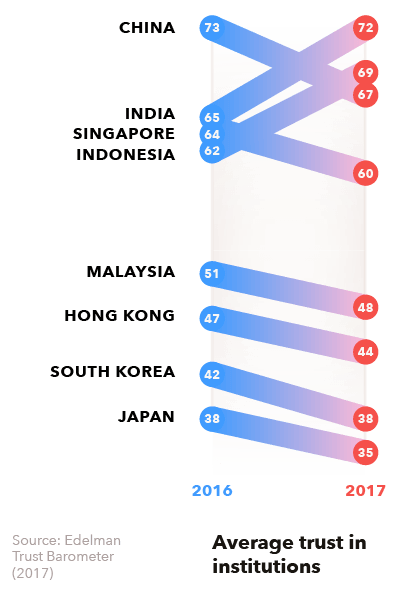Thanks to a mix of deep-rooted sociocultural traits and newfound digital superpowers, Asian consumers will embrace the truth that is personal empowerment, and the collective action that comes with it. Are you ready?
For the longest time, in many consumer societies in Asia, big institutions – governments, businesses, media, NGOs – have been famous for being unreliable. Governments? Too much corruption. Businesses? Too profit-centric! The media? Most probably manipulated and biased towards certain agendas. NGOs… well they are not so bad, but there are always stories about poor management and skepticism around the real effectiveness of such organizations. But today, that story is changing.
The new play? Power shift from traditional institutions to the collective empowerment of individuals.
Subscribe
Never miss a TrendWatching Quarterly Briefing!
Four puzzle pieces that make up the big picture
Connectivity – of course! – is bringing about new levels of availability and accessibility of information. Each individual consumer now has a (smart) phone-shaped window to the inner workings of institutions – all the bad and the ugly. The result? A general trend of falling trust in 2017.

Even in Asian societies where institutions are relatively reliable (think Singapore!), consumers with a closer look have become more critical, and the smallest fault is reason for scrutiny. Thankfully, not all is doom and gloom.
In recent years, Asia has seen the rise of unconventional figures and institutions promising change: government leaders, startup models, independent media, innovative social enterprises, and more. This is amplified again by connectivity – the same magnifying lens causing consumers to lose trust in the establishment is also inspiring faith in a new generation of institutions.
One indicator? Trust levels in Indonesia and India have actually increased, topping the charts as most trusting consumer societies in the world. Not a coincidence that both countries have seen revolutionary figures in government recently – Pak Jokowi in Indonesia and PM Narendra Modi in India.
Nevertheless, most consumer concerns won’t get solved overnight, complex as they are. People know that lone figures, no matter how revolutionary, can’t change the system overnight. But Asian consumers are also very familiar with the power collective action can wield.
Despite urbanization and the rise of individualism, communal values – a lifestyle of participation and collaboration – are still deeply embedded in culture. Indonesians with their ‘gotong-royong’, Singaporeans and the ‘kampong spirit’, the Chinese and their popular saying ‘團結力量大’, and Indians with their concept of ‘anekta mein ekta’. And together, everyone can achieve something. Just ask the South Korean netizens who, in the presidential impeachment saga, hunted down runaway government officials, disproved false claims, and more.
Finally, don’t forget the mobile and social ubiquity in the region. 1.5 billion Asians are active mobile social users – meaning massive numbers now have the means to participate. Many have leveraged the new possibilities around connection and collaboration afforded by mobile tech and social media in order to leapfrog inefficiencies and achieve shared goals. Those who don’t trust institutions can contribute to crowd-powered solutions. Those who do trust institutions can participate in collective efforts to uphold the systems they’re putting their faith in.
Witness how the brands and organizations below are responding to the new empowered Asian consumer.
Innovation examples
Featuring Peach & Lily, Seoul Metropolitan Government, Kareem and more…
Take action
So – the big picture of consumer societies of the future? It is one where individuals are empowered to participate in collective action, to shape and realize institutions – governments, businesses, media platforms, and charity organizations – that are transparent, reliable, and trustworthy.
For brands, the most fundamental implication is:
DO NOT BE EVIL.
Build a brand people can trust. Demonstrate your brand values through tangible action that inspire trust. And then think about how you can unleash the full impact of a connected, empowered community, to facilitate real-time information flow, collectively shape more reliable systems, and ultimately serve that community better.
About The Author:
Reinier
Subscribe
Never miss a TrendWatching Quarterly Briefing!
Related
Truthful Consumerism
The future of consumerism and brand strategy in a world of populism, polarization and post-truth!
Regional take
Truthful Consumerism in Latin America
Transparency and empowerment: two big, human truths for Latin innovators to run with in the post-truth era.
Regional take
Truthful Consumerism in Africa
Empowerment and tolerance: two truths for African brands to run with.
NEXT
The Bigger Picture
Learn more about our Trend-Driven Innovation methodology & how the five truths fit in.







